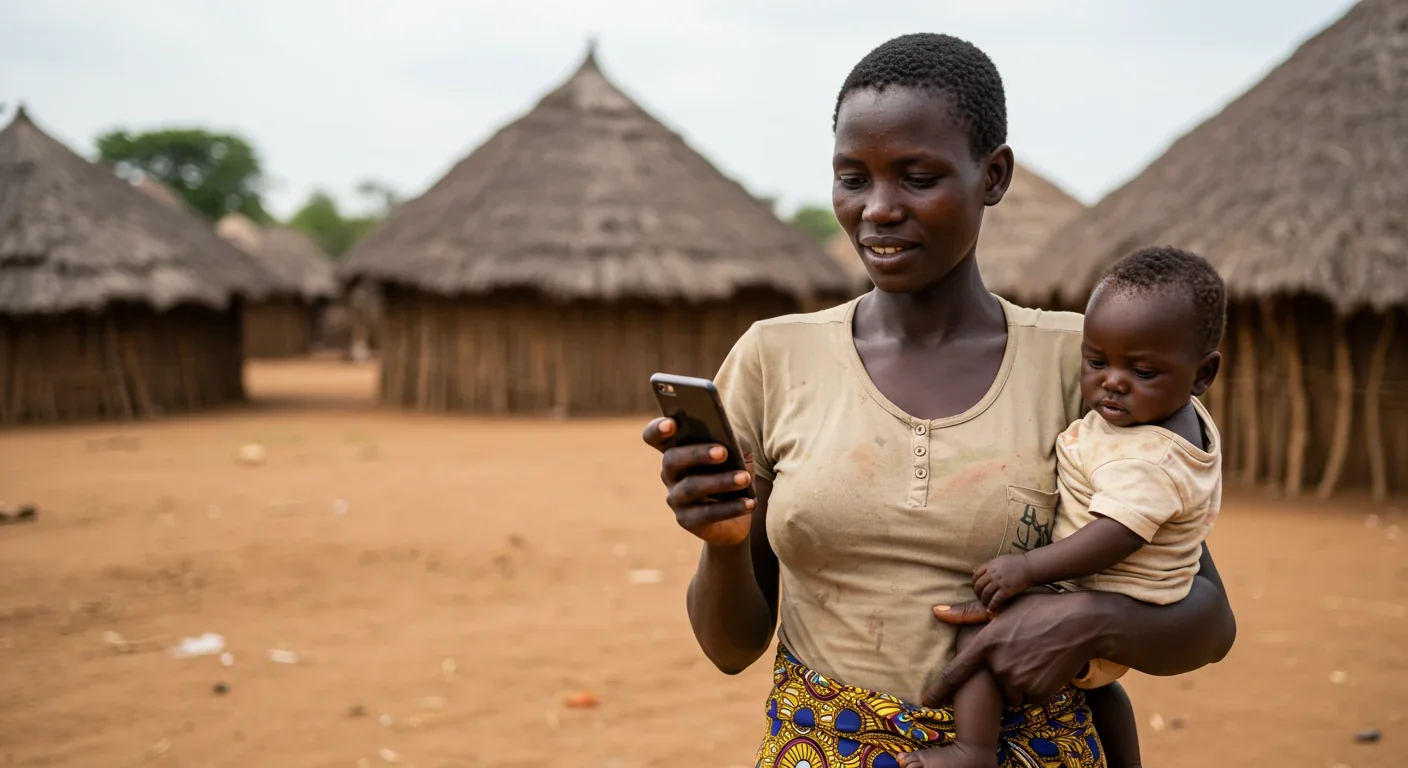Care Worker Crisis: Low Pay & Burnout Threaten Healthcare

TL;DR: Global UBI experiments from Finland to Kenya show unconditional cash doesn't reduce work effort, improves mental health, and helps recipients invest productively. The evidence challenges fears about inflation and laziness while raising questions about how to fund and scale these programs as AI threatens millions of jobs.

By 2030, economists predict that artificial intelligence will reshape nearly half of all jobs. As this transformation accelerates, governments from Helsinki to Nairobi are testing a radical solution: giving people money with no strings attached. What started as utopian speculation has become a global laboratory, and the results are rewriting our assumptions about work, poverty, and human motivation.
Over the past decade, more than 30 countries have launched Universal Basic Income experiments, each testing whether unconditional cash can solve problems that traditional welfare systems couldn't touch. Finland's 2017 trial tracked 2,000 unemployed citizens who received €560 monthly. Kenya's ongoing GiveDirectly program delivers payments to entire villages. Stockton, California gave 125 residents $500 per month. Alaska has been cutting annual oil wealth checks since 1982.
The common thread? No requirements. No job searches. No paperwork proving you're trying hard enough to deserve help. Just money, delivered directly, with recipients free to spend it however they choose.
What researchers discovered defied conventional wisdom. Contrary to fears that free money would trigger mass laziness, employment rates barely budged. In Finland, recipients reported significantly improved mental health and reduced stress levels. Stockton participants were more likely to find full-time work than the control group. Kenya's villages saw increases in entrepreneurship and livestock ownership.
The evidence suggests we've been asking the wrong question. The issue isn't whether people will work without economic pressure. It's what becomes possible when survival isn't constantly at stake.
UBI sounds simple but the implementation details matter enormously. Each experiment made different choices about amount, duration, eligibility, and funding that shaped outcomes.
Finland's trial gave unemployed people about 560 euros monthly for two years. That's enough to cover basics but not enough to live comfortably. The program was explicitly framed as a way to simplify bureaucracy and test whether unconditional income would encourage people to take temporary or part-time work without losing benefits.
Kenya's GiveDirectly program takes a more ambitious approach. Some villages receive 12 years of payments. Others get short-term or lump-sum transfers. The long timeline lets researchers track not just immediate effects but whether UBI creates lasting economic transformation. Early data shows recipients investing in home improvements, livestock, and small businesses rather than just consumption.
Stockton's Guaranteed Income pilot ran for 24 months, giving $500 monthly to residents living below the city's median income. Unlike Finland's unemployment-focused design, Stockton prioritized low-income workers who needed help making ends meet, not people who'd left the workforce.
Alaska's Permanent Fund Dividend stands apart because it's universal and permanent. Every resident receives an annual check from oil revenue investments. The 2025 payment was around $1,700. The program has run for over 40 years, making it the longest-running UBI-style system anywhere. Crucially, Alaska's inflation has trended below the U.S. average, suggesting that modest UBI doesn't automatically trigger price spirals.
The technical challenge is financing. Finland funded its trial through existing unemployment budgets, which meant it cost the government nothing extra but also limited scale. Kenya relies on philanthropic donations. Alaska taps resource wealth that few places possess. Proposals for nationwide UBI usually involve tax restructuring, reducing other benefits, or both.
The modern UBI wave builds on decades of cash transfer research. In the 1970s, the United States and Canada ran "negative income tax" experiments that guaranteed minimum incomes. Critics predicted labor supply would collapse. Instead, work hours dropped only modestly, mostly among new mothers and teenagers staying in school longer.
Those experiments were abandoned partly because political winds shifted, but also because economists weren't yet comfortable with the idea that cash might work better than in-kind benefits or conditional programs. The prevailing view held that poor people needed guidance and structure, not just money.

That changed when rigorous studies from Latin America showed that conditional cash transfers could improve health and education without massive bureaucracies. Brazil's Bolsa Família and Mexico's Progresa gave families money if their children attended school and got health checkups. The programs worked, lifting millions out of poverty. But they also revealed limitations. Conditions created administrative overhead. They sometimes excluded the most vulnerable families who couldn't meet requirements. And when payments stopped, many families slid backward.
Those insights drove the shift toward unconditional transfers. If you trust people with conditional cash, why not trust them with unconditional cash and eliminate the monitoring costs? Technology made this leap feasible. Mobile money systems let governments and NGOs deposit funds directly into recipients' accounts, cutting out middlemen and reducing fraud.
History teaches us that social policy evolves in response to economic disruption. The original welfare state emerged during industrialization when traditional village support networks collapsed. Today's UBI experiments respond to a new disruption: the potential for AI and automation to eliminate entire job categories faster than new ones emerge.
The most consistent finding across experiments is that recipients used money responsibly and poverty-related stress decreased significantly. This contradicts persistent stereotypes about poor people making bad choices.
In Kenya, researchers tracked every dollar. Recipients spent about 60% on immediate consumption like food and household goods, which makes sense given that participants started in extreme poverty. The remaining 40% went to productive investments: livestock, farm equipment, building materials, school fees. One year after payments began, households had more assets, higher food security, and lower stress levels than control villages.
Finland's outcomes centered on wellbeing rather than economics. The €560 payment wasn't enough to dramatically change living standards but it did reduce the psychological burden of navigating unemployment bureaucracy. Recipients reported better mental health, more trust in institutions, and greater confidence about their futures. Notably, employment didn't increase but it didn't decrease either. People looked for work at similar rates whether they received UBI or traditional unemployment benefits.
Stockton's results split the difference. The $500 monthly payment helped working families escape month-to-month precarity. Recipients were more likely to find full-time employment during the program, possibly because they could afford childcare, transportation, or the time to search for better jobs rather than taking the first offer. Financial volatility dropped. One participant used the money to pay off debt and save for a down payment. Another covered medical bills that had been pushed aside.
The common thread is that cash addresses the actual constraints people face. A parent can't take a better job across town without reliable childcare and gas money. An aspiring entrepreneur can't launch a business without seed capital. A student can't finish a degree while working two jobs. UBI doesn't solve everything but it removes barriers that often matter more than motivation.
Supporters claim UBI could simplify the welfare system, reduce poverty more efficiently, and give people freedom to pursue education or start businesses. Critics worry about cost, inflation, and whether it would discourage work.
The cost question is real but context-dependent. Alaska spends about $1.5 billion annually on its dividend, or roughly $2,000 per resident. That's sustainable because the Permanent Fund holds over $70 billion in investments. Scaling that nationwide would require either enormous tax increases or cuts to existing programs. The UK's Institute for Fiscal Studies calculated that a modest UBI replacing some benefits would cost an additional £67 billion yearly, requiring a 5-7% income tax increase.
Inflation fears seem overblown based on existing evidence. Alaska's program hasn't caused runaway prices. When Finland temporarily increased benefits, consumer prices didn't spike. The key distinction is between how much money enters the economy versus how it's distributed. If UBI replaces other spending rather than representing net new money creation, inflationary pressure should be minimal. Demand increases but it's redistributive, not expansionary.

The work disincentive concern has some theoretical basis but limited empirical support. Standard economic models predict that guaranteed income reduces labor supply because people value leisure and will work less if they can afford to. In practice, most experiments show modest or zero employment effects. The exceptions are concentrated among new parents and students, which many see as positive outcomes rather than problems.
What UBI might do is shift the type of work people pursue. With basic needs covered, individuals could take risks on entrepreneurship, prioritize jobs that offer training over immediate pay, or negotiate for better wages and conditions. That flexibility could increase economic dynamism rather than reducing it.
The renewed UBI push stems largely from fears that AI will eliminate jobs faster than economies can create new ones. If millions of workers face technological unemployment, how do societies maintain consumption and political stability?
Some estimates suggest that 45 million U.S. jobs could be at risk from AI within the next decade. Routine cognitive work like data entry, basic analysis, and customer service faces immediate pressure. But creative and manual labor aren't immune. AI systems now generate art, write code, and operate machinery with increasing sophistication.
Optimists argue that every previous automation wave created more jobs than it destroyed. The printing press, steam engine, and computer all sparked predictions of mass unemployment that never materialized. Pessimists counter that AI is different because it can replicate cognitive functions that define most modern work. If machines can think, what's left for humans?
UBI offers one answer. Instead of forcing people to compete against increasingly capable machines for scraps of employment, guarantee everyone enough to live on and let them find meaning outside market labor. That could involve caregiving, community organizing, creative pursuits, or education. The economy continues functioning while human dignity doesn't depend on winning an unwinnable competition.
The timing matters because AI's trajectory suggests we don't have decades to adapt. Current systems are already reshaping hiring, wage structures, and entire industries. If we wait until unemployment spikes, implementing UBI becomes politically fraught and economically destabilizing. Testing it now while unemployment is low gives societies time to refine implementation and build political support.
UBI attracts unusual political coalitions. Some progressives support it as an expansion of the welfare state. Some libertarians embrace it as a way to eliminate bureaucracy and trust individuals. Some technologists see it as necessary infrastructure for an automated economy. But it also faces opposition across the spectrum.
Conservatives often view UBI as rewarding idleness and undermining work ethic. Progressives worry it could be used to justify cutting other social programs, leaving vulnerable people worse off. Labor unions fear it might weaken collective bargaining if workers have outside income. Fiscal hawks balk at the price tag.
These tensions explain why most experiments remain small-scale. Politicians can endorse a trial that helps 2,000 people without committing to a national program costing hundreds of billions. When Finland's trial ended, the government chose not to expand it, partly because results were mixed and partly because it would require either major tax increases or cuts to services that voters value.
Public opinion varies by framing. Surveys show more support when UBI is presented as a response to automation rather than as welfare expansion. Support increases when people understand that they would receive it too, not just others. Alaska's program remains popular partly because it's genuinely universal, every resident benefits regardless of income.
The path to broader implementation probably requires incremental steps rather than revolutionary transformation. That might mean starting with targeted populations like parents with young children, expanding existing child benefits, or creating limited regional programs. As evidence accumulates and public familiarity grows, more comprehensive systems become politically viable.
The experiments have established several principles. First, unconditional cash doesn't cause mass laziness. Recipients generally use money productively and report better wellbeing. Second, modest UBI payments don't trigger inflation. Third, program design matters enormously. The amount, duration, and universality shape outcomes in ways that make generalization difficult.
What works: Payments large enough to meaningfully reduce financial stress but not so large that they create perverse incentives. Direct digital delivery that cuts administrative costs. Programs that run long enough for recipients to plan beyond month-to-month survival. Universal systems that avoid stigma and create broad political coalitions.
What doesn't work: Payments too small to matter. Short trials that don't let people adjust long-term plans. Programs that exclude marginal populations who might benefit most. Excessive conditions that reintroduce bureaucracy and barriers.
What remains uncertain: Long-term labor market effects. Whether the mental health benefits persist or represent short-term relief. Optimal payment amounts that balance adequacy against fiscal sustainability. How UBI interacts with other policies like minimum wage, housing subsidies, and healthcare. Whether permanent national programs would generate different behaviors than temporary local experiments.
The biggest gap is that no wealthy nation has implemented true UBI at scale. Alaska comes closest but the payment is small and annual rather than monthly. We don't know how people would respond to $1,000 or $2,000 monthly guaranteed for life. Would entrepreneurship surge? Would labor supply collapse? The only way to find out is to try.
Whether UBI becomes widespread policy or remains a niche experiment depends partly on how severe AI-driven unemployment proves to be. If automation concerns turn out to be overstated, the case for UBI weakens. If millions lose jobs to machines, pressure for bold action will intensify.
For individuals, the UBI conversation highlights the importance of adaptability. The skills that AI can't easily replicate involve creativity, emotional intelligence, complex problem-solving, and physical dexterity in unpredictable environments. Investing in those capabilities makes sense regardless of UBI's fate.
For policymakers, the experiments provide a roadmap. Start small. Measure rigorously. Be transparent about tradeoffs. Listen to recipients rather than assuming you know what they need. And recognize that UBI isn't a silver bullet. It works best alongside other policies that address education, healthcare, housing, and job training.
The deeper question is what kind of society we want. If AI delivers unprecedented productivity, how should those gains be shared? Should they flow primarily to capital owners and highly skilled workers, or be distributed more broadly? UBI represents one answer: technology's bounty should lift everyone, not just those who own the machines.
We're in the early stages of a conversation that will define the next century. The experiments in Finland, Kenya, Alaska, and elsewhere aren't just testing whether cash works. They're testing whether we can imagine alternatives to systems that tie human worth to employment. The results so far suggest that we can, if we choose to.

Recent breakthroughs in fusion technology—including 351,000-gauss magnetic fields, AI-driven plasma diagnostics, and net energy gain at the National Ignition Facility—are transforming fusion propulsion from science fiction to engineering frontier. Scientists now have a realistic pathway to accelerate spacecraft to 10% of light speed, enabling a 43-year journey to Alpha Centauri. While challenges remain in miniaturization, neutron management, and sustained operation, the physics barriers have ...

Epigenetic clocks measure DNA methylation patterns to calculate biological age, which predicts disease risk up to 30 years before symptoms appear. Landmark studies show that accelerated epigenetic aging forecasts cardiovascular disease, diabetes, and neurodegeneration with remarkable accuracy. Lifestyle interventions—Mediterranean diet, structured exercise, quality sleep, stress management—can measurably reverse biological aging, reducing epigenetic age by 1-2 years within months. Commercial ...

Data centers consumed 415 terawatt-hours of electricity in 2024 and will nearly double that by 2030, driven by AI's insatiable energy appetite. Despite tech giants' renewable pledges, actual emissions are up to 662% higher than reported due to accounting loopholes. A digital pollution tax—similar to Europe's carbon border tariff—could finally force the industry to invest in efficiency technologies like liquid cooling, waste heat recovery, and time-matched renewable power, transforming volunta...

Humans are hardwired to see invisible agents—gods, ghosts, conspiracies—thanks to the Hyperactive Agency Detection Device (HADD), an evolutionary survival mechanism that favored false alarms over fatal misses. This cognitive bias, rooted in brain regions like the temporoparietal junction and medial prefrontal cortex, generates religious beliefs, animistic worldviews, and conspiracy theories across all cultures. Understanding HADD doesn't eliminate belief, but it helps us recognize when our pa...

The bombardier beetle has perfected a chemical defense system that human engineers are still trying to replicate: a two-chamber micro-combustion engine that mixes hydroquinone and hydrogen peroxide to create explosive 100°C sprays at up to 500 pulses per second, aimed with 270-degree precision. This tiny insect's biochemical marvel is inspiring revolutionary technologies in aerospace propulsion, pharmaceutical delivery, and fire suppression. By 2030, beetle-inspired systems could position sat...

The U.S. faces a catastrophic care worker shortage driven by poverty-level wages, overwhelming burnout, and systemic undervaluation. With 99% of nursing homes hiring and 9.7 million openings projected by 2034, the crisis threatens patient safety, family stability, and economic productivity. Evidence-based solutions—wage reforms, streamlined training, technology integration, and policy enforcement—exist and work, but require sustained political will and cultural recognition that caregiving is ...

Every major AI model was trained on copyrighted text scraped without permission, triggering billion-dollar lawsuits and forcing a reckoning between innovation and creator rights. The future depends on finding balance between transformative AI development and fair compensation for the people whose work fuels it.